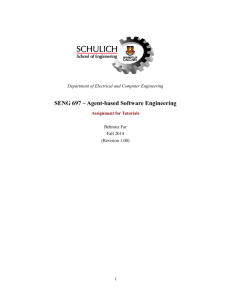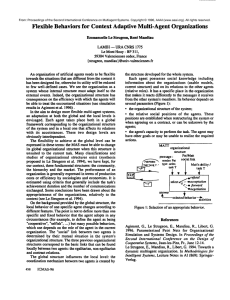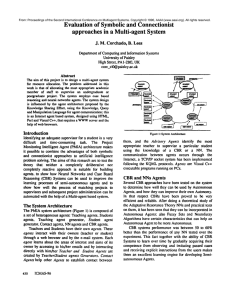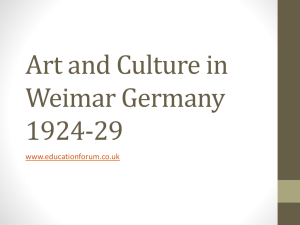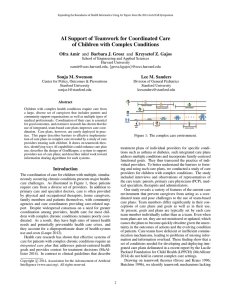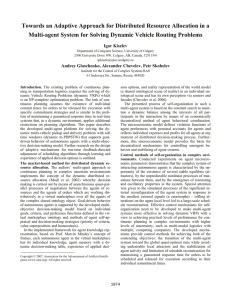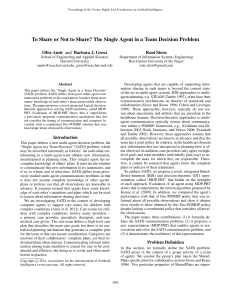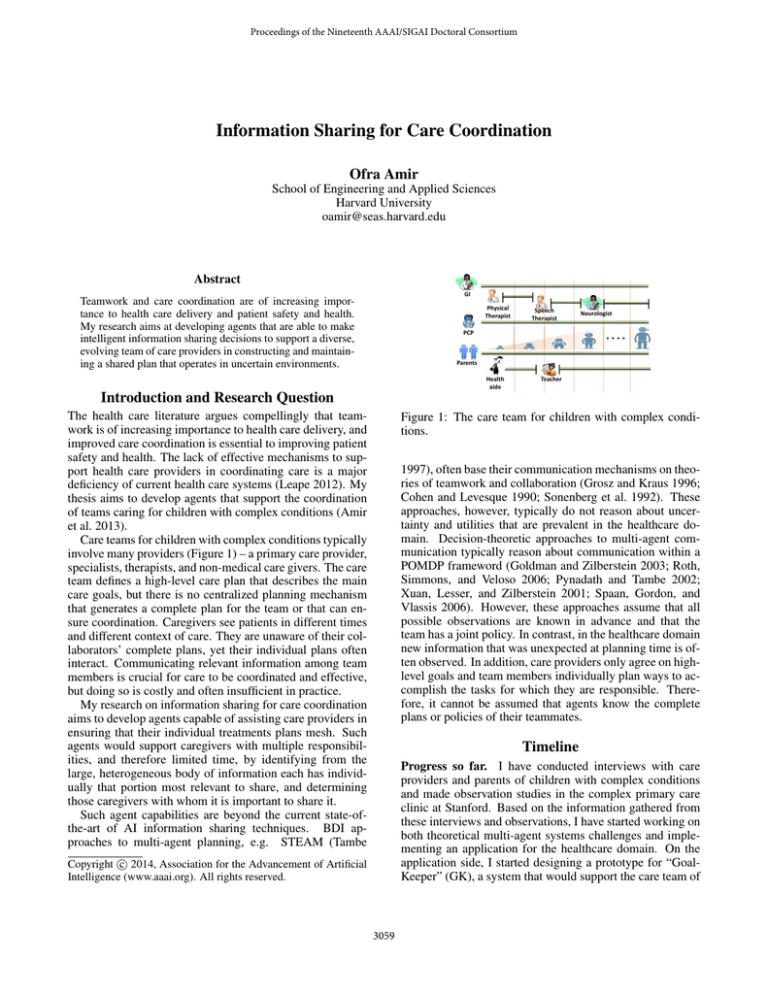
Proceedings of the Nineteenth AAAI/SIGAI Doctoral Consortium
Information Sharing for Care Coordination
Ofra Amir
School of Engineering and Applied Sciences
Harvard University
oamir@seas.harvard.edu
Abstract
GI
Teamwork and care coordination are of increasing importance to health care delivery and patient safety and health.
My research aims at developing agents that are able to make
intelligent information sharing decisions to support a diverse,
evolving team of care providers in constructing and maintaining a shared plan that operates in uncertain environments.
Physical
Therapist
Speech
Therapist
Neurologist
PCP
Parents
Health
aide
Teacher
Introduction and Research Question
The health care literature argues compellingly that teamwork is of increasing importance to health care delivery, and
improved care coordination is essential to improving patient
safety and health. The lack of effective mechanisms to support health care providers in coordinating care is a major
deficiency of current health care systems (Leape 2012). My
thesis aims to develop agents that support the coordination
of teams caring for children with complex conditions (Amir
et al. 2013).
Care teams for children with complex conditions typically
involve many providers (Figure 1) – a primary care provider,
specialists, therapists, and non-medical care givers. The care
team defines a high-level care plan that describes the main
care goals, but there is no centralized planning mechanism
that generates a complete plan for the team or that can ensure coordination. Caregivers see patients in different times
and different context of care. They are unaware of their collaborators’ complete plans, yet their individual plans often
interact. Communicating relevant information among team
members is crucial for care to be coordinated and effective,
but doing so is costly and often insufficient in practice.
My research on information sharing for care coordination
aims to develop agents capable of assisting care providers in
ensuring that their individual treatments plans mesh. Such
agents would support caregivers with multiple responsibilities, and therefore limited time, by identifying from the
large, heterogeneous body of information each has individually that portion most relevant to share, and determining
those caregivers with whom it is important to share it.
Such agent capabilities are beyond the current state-ofthe-art of AI information sharing techniques. BDI approaches to multi-agent planning, e.g. STEAM (Tambe
Figure 1: The care team for children with complex conditions.
1997), often base their communication mechanisms on theories of teamwork and collaboration (Grosz and Kraus 1996;
Cohen and Levesque 1990; Sonenberg et al. 1992). These
approaches, however, typically do not reason about uncertainty and utilities that are prevalent in the healthcare domain. Decision-theoretic approaches to multi-agent communication typically reason about communication within a
POMDP frameword (Goldman and Zilberstein 2003; Roth,
Simmons, and Veloso 2006; Pynadath and Tambe 2002;
Xuan, Lesser, and Zilberstein 2001; Spaan, Gordon, and
Vlassis 2006). However, these approaches assume that all
possible observations are known in advance and that the
team has a joint policy. In contrast, in the healthcare domain
new information that was unexpected at planning time is often observed. In addition, care providers only agree on highlevel goals and team members individually plan ways to accomplish the tasks for which they are responsible. Therefore, it cannot be assumed that agents know the complete
plans or policies of their teammates.
Timeline
Progress so far. I have conducted interviews with care
providers and parents of children with complex conditions
and made observation studies in the complex primary care
clinic at Stanford. Based on the information gathered from
these interviews and observations, I have started working on
both theoretical multi-agent systems challenges and implementing an application for the healthcare domain. On the
application side, I started designing a prototype for “GoalKeeper” (GK), a system that would support the care team of
c 2014, Association for the Advancement of Artificial
Copyright Intelligence (www.aaai.org). All rights reserved.
3059
2015) I plan to integrate information sharing algorithms and
plan elicitation mechanisms into GK and run small-scale experiments with larger groups of families and care providers.
I will iterate between experimenting with new GK capabilities and refining the algorithms and representations based on
these experiments. In my final year (Fall 2015-Spring 2016)
I will focus on evaluating GK with larger scale experiments
in the healthcare domain and writing my thesis.
children with complex conditions.
As a first step in the theoretical work, we formally defined
the information sharing problem that arises in the healthcare
domain as the “Single Agent in a Team Decision” (SATD)
problem (Amir, Grosz, and Stern 2014). Informally, SATD
can be desribed as follows: an individual collaborating in a
multi-agent team obtains new information, unanticipated at
planning time. This (single) agent has incomplete knowledge of others’ plans. It must decide whether to communicate this new information to its teammates, and if so, to
whom, and at what time. SATD differs from previously studied multi-agent communications problems in that it does not
assume complete knowledge of other agents’ plans or policies nor that all observations are knowable in advance. It
assumes instead that agents have some knowledge of each
other’s intentions and plans which can be used to reason
about information sharing decisions.
To address this problem we proposed an integrated BeliefDesire-Intention (BDI) and decision-theoretic (DT) representation, “MDP-PRT”, that builds on the strengths of each
approach. This approach integrates the Probabilistic Recipe
Trees (PRT) representation of an agent’s beliefs about another agent’s plans (Kamar, Gal, and Grosz 2009) with a
Markov Decision Process (MDP) to support a collaborating
group in their execution of a plan. Results from empirical
evaluation show that it outperforms the inform algorithm
proposed by Kamar et al. (2009) and that it obtains results
close to those obtained by this Dec-POMDP policy despite
lacking a coordinated policy that considers all possible observations.
Expected progress by the workshop. I am currently
working on an initial “Wizard of Oz” pilot study with two
families of children with complex conditions and three of
their care providers to simulate the use of GK. In this study,
parents and their providers will form care plans for the child
and parents will submit these status updates about the child’s
condition to the system. The status updates will be reviewed
by the participating care providers who will identify the information that is important to them and at the time they
would have wanted the system to inform them. Similarly,
parents will be presented with different summaries of the
data and asked about their preferences. This study will help
us to better understand the needs of care providers and patients’ families and will inform the design of GK and the
information sharing algorithms.
Another question related to information sharing in the
context of collaborative plans is how to convey changes
in plans to team members. We hypothesize that the effectiveness of different methods for communicating changes in
plans will depend not only on the extent of changes in the
plan, but also on the extent to which the agent deploys context and information about an individual’s role in the plan in
designing its communication. We are currently designing an
initial study to explore this question in order to develop an
intelligent interface that would be capable of familiarizing
team members with the team plan as it evolves in an effective way. By July, I expect to have results from preliminary
experiments.
Future research directions. Next year (Fall 2014-Spring
Acknowledgements
The research is supported in part by a grant from the Nuance
Foundation.
References
Amir, O.; Grosz, B. J.; Law, E.; and Stern, R. 2013. Collaborative health care plan support. In Proceedings of the 12th
international conference on Autonomous agents and multiagent systems, 793–796.
Amir, O.; Grosz, B. J.; and Stern, R. 2014. To share or
not to share? the single agent in a team decision problem.
In Workshop: Models and Paradigms for Planning under
Uncertainty: a Broad Perspective.
Cohen, P., and Levesque, H. 1990. Intention is choice with
commitment. Artificial intelligence 42(2):213–261.
Goldman, C. V., and Zilberstein, S. 2003. Optimizing information exchange in cooperative multi-agent systems. In
Proceedings of the second international joint conference on
Autonomous agents and multiagent systems, 137–144.
Grosz, B., and Kraus, S. 1996. Collaborative plans for complex group action. Artificial Intelligence 86(2):269–357.
Kamar, E.; Gal, Y.; and Grosz, B. 2009. Incorporating
helpful behavior into collaborative planning. In Proceedings
of The 8th International Conference on Autonomous Agents
and Multiagent Systems, 875–882.
Leape, L. 2012. Order From Chaos: Accelerating Care
Integration. National Patient Safety Foundation.
Pynadath, D. V., and Tambe, M. 2002. The communicative
multiagent team decision problem: analyzing teamwork theories and models. Journal of Artificial Intelligence Research
16(1):389–423.
Roth, M.; Simmons, R.; and Veloso, M. 2006. What to communicate? execution-time decision in multi-agent POMDPs.
Distributed Autonomous Robotic Systems 7 177–186.
Sonenberg, E.; Tidhar, G.; Werner, E.; Kinny, D.; Ljungberg, M.; and Rao, A. 1992. Planned team activity. Artificial
Social Systems 890.
Spaan, M. T.; Gordon, G. J.; and Vlassis, N. 2006. Decentralized planning under uncertainty for teams of communicating agents. In the fifth international joint conference on
Autonomous agents and multiagent systems, 249–256.
Tambe, M. 1997. Agent architectures for flexible practical
teamwork. AAAI 97(1):997.
Xuan, P.; Lesser, V.; and Zilberstein, S. 2001. Communication decisions in multi-agent cooperation: Model and experiments. In Proceedings of the fifth international conference
on Autonomous agents, 616–623.
3060

